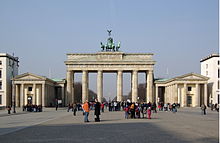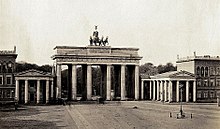Brandenburg Gate
![]()
This article is about the gate in Berlin. For other buildings, see Brandenburg Gate (disambiguation).
The Brandenburg Gate in Berlin is an Early Classicist triumphal gate that stands on the western flank of the square Pariser Platz in Berlin's Mitte district. It was built as the conclusion of the central boulevard of the Dorotheenstadt, the boulevard Unter den Linden, in the years from 1789 to 1793 on the orders of the Prussian King Frederick William II according to designs by Carl Gotthard Langhans. The sculpture of the Quadriga crowning the gate was designed by the sculptor Johann Gottfried Schadow. To the west of the Brandenburg Gate are the extensive green spaces of the Großer Tiergarten, which are crossed by the Straße des 17. Juni in a straight extension of the street Unter den Linden. The square immediately west of the gate bears the name Platz des 18. März.
The gate is the only surviving one of the last 18 city gates in Berlin. In its formal language it represents the turn from the Roman to the Greek model. It is one of the first classicistic buildings in Prussia and marks the beginning of classicism as state architecture in Prussia.
The gate is the most famous Berlin landmark and a German national symbol, with which many important historical events of the 19th and 20th centuries are associated. Thus, until the Second World War, the end of Napoleonic rule 1813-1815 in particular was associated with the structure. During the Weimar Republic, Constitution Day was celebrated here every year on 11 August. Until the opening of the Iron Curtain, the Brandenburg Gate stood directly on the border between East and West Berlin, symbolizing the clash of the Warsaw Pact and NATO at the most sensitive point of their common border during the Cold War. Accordingly, since 1990 the Brandenburg Gate has also been regarded as a symbol of the overcoming of the division of Germany and Europe.
After severe war damage, the gate was restored until 1958. A comprehensive, almost two-year restoration took place until 2002 by the Stiftung Denkmalschutz Berlin.

The Brandenburg Gate from the east (Pariser Platz), 2011

West side of the Brandenburg Gate in divided Berlin, 1985

The Brandenburg Gate in the Kingdom of Prussia, around 1855
Previous building
With the construction of the Dorotheenstadt around 1670 and its inclusion in the city fortifications of Berlin, the first gate was built on the site of today's Brandenburg Gate. It consisted of a breakthrough through the heaped-up rampart and a drawbridge over the excavated moat.
With the construction of the customs wall of the city of Berlin, a predecessor of today's Brandenburg Gate was erected in 1734 as a city gate on the road to Brandenburg an der Havel by Philipp Gerlach. The gate consisted of two baroque pylons decorated with pilasters and trophies, to which the gate wings were attached. Next to the decorative gate were simple passages for pedestrians in the wall, which were decorated with decorative vases at this point. Already inside the customs wall, to the south of the gate was the building for the guard and to the north that for the tax authority.
For the forthcoming construction of the new gate, the fire station to the north of the wheelhouse was first demolished in May 1788 in order to build a temporary bypass around the gate construction site. The demolition of the old Brandenburg Gate then began in the summer of 1788.

Drawing of the old Brandenburg Gate by Daniel Chodowiecki, 1764
Symbolism
The Brandenburg Gate was rebuilt to represent Frederick William II's rule in domestic and foreign policy terms. In the first drafts, it was therefore suggested that Federigo be inscribed on it in bronze letters. By designing the gate on the model of the Propylaea of the Acropolis of the Parthenon Temple in Athens, Frederick William II compared himself to Pericles and portrayed himself as a ruler who would bring Prussia a golden age. Pericles stood for a clever alliance policy combined with a long period of peace and for the supremacy of Athens in the Attic Sea League. This was exactly how Frederick William II wanted to be perceived after he forcibly pacified the Republic of the United Netherlands by the invasion of Prussian troops in 1787 and brought about an alliance between Prussia, the Netherlands and Great Britain.
The name "Peace Gate" originally chosen for the gate was entirely in this spirit. Alongside Frederick William II, his sister Wilhelmine of Orange, hereditary governor of the Republic of the Netherlands, was to be praised as the bringer of peace. It was she who, through her tactics, persuaded Frederick William II to intervene in the Netherlands and ultimately thereby brought about Prussia's supremacy in Europe. The concept of the "Gate of Peace" does not contradict the crowning of the gate with a goddess of victory, but harmonizes with the absolutist concept of rule in the 18th century.
Both in terms of the structural design of the wing buildings and the decorative furnishings, the gate was directed inwards. It was thus not intended to demonstrate the power of the ruler to those arriving, but to those living in the city. Like a theatrical backdrop, the gate served to provide the king with decorative and elevating accessories on his arrival in Berlin.
Questions and Answers
Q: What is the Brandenburg Gate?
A: The Brandenburg Gate is a structure in Berlin, Germany. It was built between 1788 and 1791 and is the only remaining gate through which people used to enter Berlin.
Q: Where is the Brandenburg Gate located?
A: The Brandenburg Gate is located between the Platz des 18. März and the Pariser Platz, near to the north of the Reichstag building.
Q: How many columns does it have?
A: The Brandenburg Gate has twelve columns, six on each side of its entrance and exit.
Q: What did Prussian General Ernst von Pfuel do when Napoleon was defeated in 1814?
A: When Napoleon was defeated in 1814, Prussian General Ernst von Pfuel occupied Paris and took back to Berlin the Quadriga that Napoleon had stolen from there earlier.
Q: How did Nazis use it as their symbol?
A: When Nazis came to power they used the Brandenburg Gate as their symbol by placing banners with Nazi symbols across it.
Q: Why was it closed when Berlin Wall was built in 1961?
A: The Brandenburg Gate was closed when Berlin Wall was built in 1961 because it stood right at its center, within what became known as "the death strip".
Q: Who said “The German question will remain open as long as the Brandenburg Gate is closed” ?
A: West Berlin mayor Richard von Weizsäcker said “The German question will remain open as long as the Brandenburg Gate is closed” during 1980s .
Search within the encyclopedia